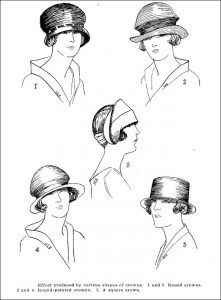
In the early 20th century, keeping your family clothed wasn’t nearly as easy as it is today. Now, online shopping and large retail stores give us access to thousands of clothing options, but a century ago, clothing items were more expensive and often were not mass-produced, and many people still sewed their own clothing. As a result, mothers and housewives spent a great deal of effort mending, repairing, and caring for their family’s wardrobes. This is evidenced by publications from the Extension Service of the Colorado Agricultural College (today’s Colorado State University).
The Extension produced – and still produces – hundreds of bulletins, pamphlets, and factsheets that offer simple advice on agriculture, gardening, and home economics. Among the bulletins produced in the 1920s include several on how to care for clothing. For anyone researching early 20th century fashion and domestic life, these bulletins are excellent primary sources. Some of the 1920s titles include Simple Articles for Clothing and Household Use (1923); Clothing Clubs (1923); Baby Bunting’s Clothing Budget (1924); Blouses, Skirts and Dresses (1924); Planning One’s Clothes (1924); and Care of Clothing (1925). Although published in the flush times of the ’20s, their tips on caring for and prolonging the life of garments would become especially helpful to those affected by the Great Depression in the 1930s.
When WWII broke out, some clothing items were rationed while many clothing factories shifted from civilian consumer goods to the production of war materiel. Therefore, those on the homefront were encouraged to make do with what they had, or to remodel older garments into new uses. In 1942 the Extension produced Care of Clothing: Daily-Weekly-Seasonal; Care of Woolen Clothing; and Remodeling Clothing.
By the 1970s, clothing was becoming cheaper and more mass-produced, so the Extension began focusing on more on creative sewing, as well as how families, especially those on farms and in rural areas with less access to cheap consumer goods, could maximize their clothing budgets. 1970s titles included Rags to Riches: Recycle Your Clothes and Western Wear Wisdom.
Finally, in the 1990s, clothing became so mass-produced that many people had never learned the most basic mending techniques. The Extension came to the rescue with publications like Fixing a Torn Loose Pocket; Making a New Hem; Patching Knees in Pants; Replacing a Jacket Zipper; Replacing Elastic in Skirts or Pants; and Replacing Torn-Off Buttons.
In the 20th century, it wasn’t just the fashions themselves that changed, but people’s approach to buying and owning clothes changed as well. Check out these and other publications from the CSU Extension, available from our library, to learn more.
- How to Spot the Differences Between Eagles and Hawks - August 16, 2021
- How Transportation Projects Help Tell the Story of Colorado’s Past - August 9, 2021
- Time Machine Tuesday: The Night the Castlewood Canyon Dam Gave Way - August 3, 2021